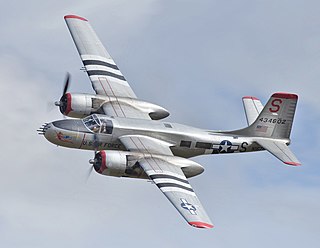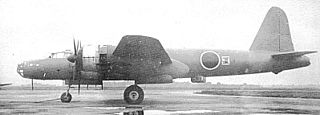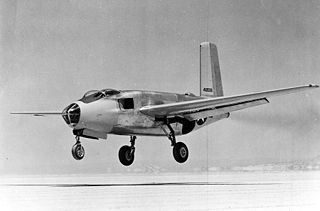
The Consolidated B-24 Liberator is an American heavy bomber, designed by Consolidated Aircraft of San Diego, California. It was known within the company as the Model 32, and some initial production aircraft were laid down as export models designated as various LB-30s, in the Land Bomber design category.

The CAC Boomerang is a fighter aircraft designed and manufactured in Australia by the Commonwealth Aircraft Corporation between 1942 and 1945. Approved for production shortly following the Empire of Japan's entry into the Second World War, the Boomerang was rapidly designed as to meet the urgent demands for fighter aircraft to equip the Royal Australian Air Force (RAAF). It was the first combat aircraft designed and constructed in Australia.

The McDonnell XF-88 Voodoo was a long-range, twinjet fighter aircraft with swept wings designed for the United States Air Force. Although it never entered production, its design was adapted for the subsequent supersonic F-101 Voodoo.

The Douglas B-18 Bolo is an American heavy bomber which served with the United States Army Air Corps and the Royal Canadian Air Force during the late 1930s and early 1940s. The Bolo was developed by the Douglas Aircraft Company from their DC-2 as a replacement for the Martin B-10.

The Martin B-26 Marauder is an American twin-engined medium bomber that saw extensive service during World War II. The B-26 was built at two locations: Baltimore, Maryland, and Omaha, Nebraska, by the Glenn L. Martin Company.

The Consolidated B-32 Dominator was an American heavy strategic bomber built for United States Army Air Forces during World War II, which had the distinction of being the last Allied aircraft to be engaged in combat during World War II; that engagement also resulted in the last American to die in air combat in World War II. It was developed by Consolidated Aircraft in parallel with the Boeing B-29 Superfortress as a fallback design should the B-29 prove unsuccessful. The B-32 reached units in the Pacific only in mid-May 1945, and subsequently saw only limited combat operations against Japanese targets before the formal end of the war on 2 September 1945. Most of the extant orders of the B-32 were canceled shortly thereafter and only 118 B-32 airframes of all types were built.

The Douglas XTB2D Skypirate was a torpedo bomber intended for service with the United States Navy's Midway- and Essex-class aircraft carriers; it was too large for earlier decks. Two prototypes were completed, but the dedicated torpedo bomber was becoming an outdated concept, and with the end of World War II, the type was deemed unnecessary and cancelled.

The Northrop YB-35/XB-35, Northrop designation N-9 or NS-9, were experimental heavy bomber aircraft developed by the Northrop Corporation for the United States Army Air Forces during and shortly after World War II. The airplane used the radical and potentially very efficient flying wing design, in which the tail section and fuselage are eliminated and all payload is carried in a thick wing. Only prototypes and pre-production aircraft were built, although interest remained strong enough to warrant further development of the design as a jet bomber, under the designation YB-49.

The Douglas A-20 Havoc is an American light bomber, attack aircraft, night intruder, night fighter, and reconnaissance aircraft of World War II.

The Douglas A-26 Invader is an American twin-engined light bomber and ground attack aircraft. Built by Douglas Aircraft Company during World War II, the Invader also saw service during several major Cold War conflicts. A limited number of highly modified United States Air Force aircraft served in Southeast Asia until 1969. It was a fast aircraft capable of carrying a large bomb load. A range of guns could be fitted to produce a formidable ground-attack aircraft.

The Douglas Y1B-7 was a 1930s American bomber aircraft. It was the first US monoplane given the B- 'bomber' designation. The monoplane was more practical and less expensive than the biplane, and the United States Army Air Corps chose to experiment with monoplanes for this reason. At the time the XB-7 was ordered, it was being tested by Douglas Aircraft as an observational plane.

The Douglas XB-19 was a four-engined, piston-driven heavy bomber produced by the Douglas Aircraft Company for the United States Army Air Forces (USAAF) during the early 1940s. The design was originally given the designation XBLR-2. It was the largest bomber built for the USAAF until 1946, with the Convair B-36 surpassing it in size.

The Nakajima G8N Renzan was a four-engine long-range bomber designed for use by the Imperial Japanese Navy. The Navy designation was "Type 18 land-based attack aircraft" (十八試陸上攻撃機); the Allied code name was "Rita".

The Dornier Do 19 was a German four-engine heavy bomber that first flew on 28 October 1936. Only one prototype flew, and it was converted to a transport in 1938. The other two were scrapped.

The Martin Model 167 Maryland was an American light bomber that first flew in 1939. It saw action in World War II with France and the United Kingdom.

The Boeing YB-9 was the first all-metal monoplane bomber aircraft designed for the United States Army Air Corps. The YB-9 was a much enlarged twin-engine development of Boeing's single-engine Model 200 Monomail commercial transport.

The Douglas XB-43 Jetmaster is an American 1940s jet-powered prototype bomber. The XB-43 was a development of the XB-42, replacing the piston engines of the XB-42 with two General Electric J35 engines of 4,000 lbf (17.8 kN) thrust each. Despite being the first American jet bomber to fly, it suffered stability issues and the design did not enter production.

The Avro Type 557 Ava was a British twin-engined biplane torpedo bomber of the 1920s. It was developed by Avro to meet a requirement for a heavy torpedo bomber for the Royal Air Force but was unsuccessful, only two prototypes being built.

The Douglas Cloudster II was an American prototype five-seat light aircraft of the late 1940s. It was of unusual layout, with two buried piston engines driving a single pusher propeller. Only a single example was built, which flew only twice, as it proved too expensive to be commercially viable.
The Douglas Model 423 was a bomber aircraft design developed by American aircraft manufacturer Douglas to compete with the Convair B-36 design for a major U.S. Army Air Force contract for an intercontinental bomber in 1941. Although identified as the Douglas XB-31 in some publications, the project documents indicate that it was designed much later than the R40-B competition.























